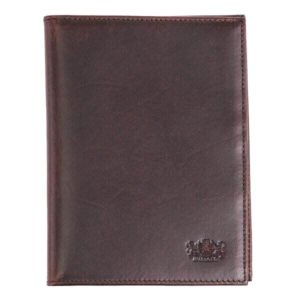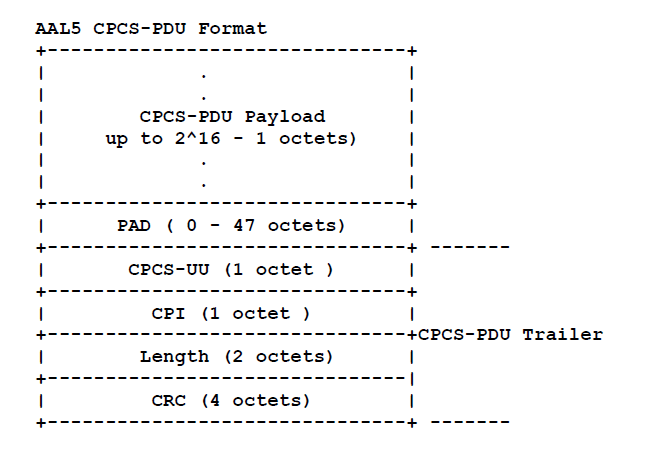
Multiprotocol Encapsulation over ATM Adaptation Layer 5
Posted on |
Multiprotocol Encapsulation over ATM Adaptation Layer 5
This specification is intended to be used in implementations which use ATM networks to carry multiprotocol traffic among hosts, routers, and bridges which are ATM end systems.
Asynchronous Transfer Mode (ATM) wide area, campus, and local area networks are used to transport IP datagrams and other connectionless traffic between hosts, routers, bridges and other networking devices. This memo describes two methods for carrying connectionless routed and bridged Protocol Data Units (PDUs) over an ATM network. The “LLC Encapsulation” method allows multiplexing of multiple protocols over a single ATM virtual connection (VC). The protocol type of each PDU is identified by a prefixed IEEE 802.2 Logical Link Control (LLC) header. In the “VC Multiplexing” method, each ATM VC carries PDUs of exactly one protocol type. When multiple protocols need to be transported here is a separate VC for each.
The unit of transport in ATM is a 53 octet fixed length PDU called a cell. A cell consists of a 5 octet header and a 48 byte payload. Variable length PDUs, including those addressed in this memo, must be segmented by the transmitter to fit into the 48 octet ATM cell payload, and reassembled by the receiver. This memo specifies the use of the ATM Adaptation Layer type 5 (AAL5), as defined in ITU-T Recommendation I.363.5 for this purpose. Variable length PDUs are carried in the Payload field of the AAL5 Common Part Convergence Sublayer (CPCS) PDU.
This memo only describes how routed and bridged PDUs are carried directly over the AAL5 CPCS, i.e., when the Service Specific Convergence Sublayer (SSCS) of AAL5 is absent. If Frame Relay Service Specific Convergence Sublayer (FR-SSCS), as defined in ITU-T Recommendation I.365.1, is used over the CPCS, then routed and bridged PDUs are carried using the NLPID multiplexing method described in RFC 2427. The RFC 2427 encapsulation MUST be used in the special case that Frame Relay Network Interworking or transparent mode Service Interworking are used, but is NOT RECOMMENDED for other applications. Appendix A (which is for information only) shows the format of the FR-SSCS-PDU as well as how IP and CLNP PDUs are encapsulated over FR-SSCS according to RFC 2427.
This memo also includes an optional encapsulation for use with Virtual Private Networks that operate over an ATM subnet.
If it is desired to use the facilities which are designed for the Point-to-Point Protocol (PPP), and there exists a point-to-point relationship between peer systems, then RFC 2364, rather than this memo, applies.
Selection of the Multiplexing Method
The decision as to whether to use LLC encapsulation or VC-multiplexing depends on implementation and system requirements. In general, LLC encapsulation tends to require fewer VCs in a multiprotocol environment. VC multiplexing tends to reduce fragmentation overhead (e.g., an IPV4 datagram containing a TCP control packet with neither IP nor TCP options exactly fits into a single cell).
When two ATM end systems wish to exchange connectionless PDUs across an ATM Permanent Virtual Connection (PVC), selection of the multiplexing method is done by configuration. ATM connection control signalling procedures are used to negotiate the encapsulation method when ATM Switched Virtual Connections (SVCs) are to be used and specify how this negotiation is done.
 |  |  |
Mens underwears from STEVENEVEN.COM
AAL5 PDU Format
For both multiplexing methods, routed and bridged PDUs MUST be encapsulated within the Payload field of an AAL5 CPCS-PDU.
ITU-T Recommendation I.363.5 provides the complete definition of the AAL5 PDU format and procedures at the sender and receiver. The AAL5 message mode service, in the non-assured mode of operation, MUST be used. The corrupted delivery option MUST NOT be used. A reassembly timer MAY be used. The following description is provided for information.

The Payload field contains user information up to 2^16 – 1 octets.
The PAD field pads the CPCS-PDU to fit exactly into the ATM cells such that the last 48 octet cell payload created by the SAR sublayer will have the CPCS-PDU Trailer right justified in the cell.
The CPCS-UU (User-to-User indication) field is used to transparently transfer CPCS user to user information. The field is not used by the multiprotocol ATM encapsulation described in this memo and MAY be set to any value.
The CPI (Common Part Indicator) field aligns the CPCS-PDU trailer to 64 bits. This field MUST be coded as 0x00.
The Length field indicates the length, in octets, of the Payload field. The maximum value for the Length field is 65535 octets. A Length field coded as 0x00 is used for the abort function.
The CRC field is used to detect bit errors in the CPCS-PDU. A CRC-32 is used.
LLC Encapsulation
LLC Encapsulation is needed when more than one protocol might be carried over the same VC. In order to allow the receiver to properly process the incoming AAL5 CPCS-PDU, the Payload Field contains information necessary to identify the protocol of the routed or bridged PDU. In LLC Encapsulation, this information MUST be encoded in an LLC header placed in front of the carried PDU.
Although this memo only deals with protocols that operate over LLC Type 1 (unacknowledged connectionless mode) service, the same encapsulation principle also applies to protocols operating over LLC Type 2 (connection-mode) service. In the latter case, the format and contents of the LLC header would be as described in IEEE 802.1 and IEEE 802.2.
LLC Encapsulation for Routed Protocols
 In LLC Encapsulation for routed protocols, the Control field MUST be set to 0x03, specifying a Unnumbered Information (UI) Command PDU.
In LLC Encapsulation for routed protocols, the Control field MUST be set to 0x03, specifying a Unnumbered Information (UI) Command PDU.
The LLC header value 0xFE-FE-03 MUST be used to identify a routed PDU in the ISO NLPID format (see Appendix B). For NLPID-formatted routed PDUs, the content of the AAL5 CPCS-PDU Payload field MUST be as follows:

The routed protocol MUST be identified by a one octet NLPID field that is part of Protocol Data. NLPID values are administered by ISO and ITU-T. They are defined in ISO/IEC TR 9577 [6] and some of the currently defined ones are listed in Appendix C.
A NLPID value of 0x00 is defined in ISO/IEC TR 9577 as the Null Network Layer or Inactive Set. Since it has no significance within the context of this encapsulation scheme, a NLPID value of 0x00 MUST NOT be used.
Although there is a NLPID value (0xCC) that indicates IP, the NLPID format MUST NOT be used for IP. Instead, IP datagrams MUST be identified by a SNAP header, as defined below.
The presence of am IEEE 802.1a SNAP header is indicated by the LLC header value 0xAA-AA-03. A SNAP header is of the form

The SNAP header consists of a three octet Organizationally Unique Identifier (OUI) and a two octet Protocol Identifier (PID). The OUI is administered by IEEE and identifies an organization which administers the values which might be assigned to the PID. The SNAP header thus uniquely identifies a routed or bridged protocol. The OUI value 0x00-00-00 indicates that the PID is an EtherType.
The format of the AAL5 CPCS-PDU Payload field for routed non-NLPID Formatted PDUs MUST be as follows:

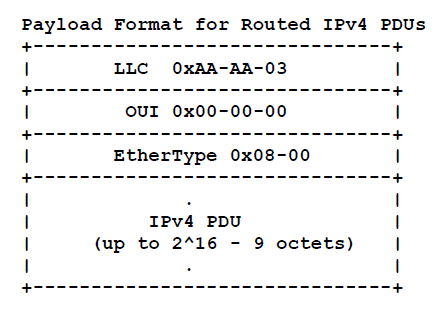
LLC Encapsulation for Bridged Protocols
In LLC Encapsulation, bridged PDUs are encapsulated by identifying the type of the bridged media in the SNAP header. The presence of the SNAP header MUST be indicated by the LLC header value 0xAA-AA-03. The OUI value in the SNAP header MUST be the 802.1 organization code 0x00-80-C2. The type of the bridged media MUST be specified by the two octets PID. The PID MUST also indicate whether the original Frame Check Sequence (FCS) is preserved within the bridged PDU. Appendix B provides a list of media type (PID) values that can be used in ATM encapsulation.
The AAL5 CPCS-PDU Payload field carrying a bridged PDU MUST have one of the following formats. The necessary number of padding octets MUST be added after the PID field in order to align the Ethernet/802.3 LLC Data field, 802.4 Data Unit field, 802.5 Info field, FDDI Info field or 802.6 Info field (respectively) of the bridged PDU to begin at a four-octet boundary. The bit ordering of the MAC address MUST be the same as it would be on the LAN or MAN
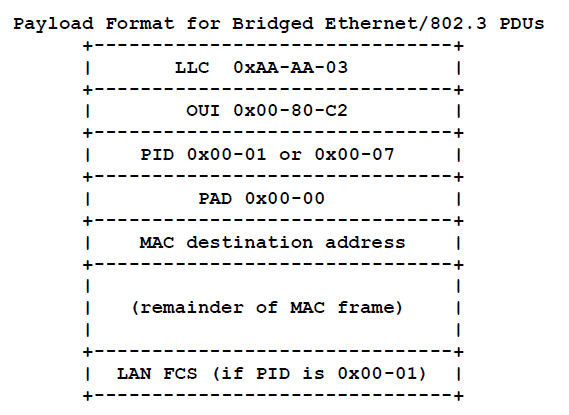

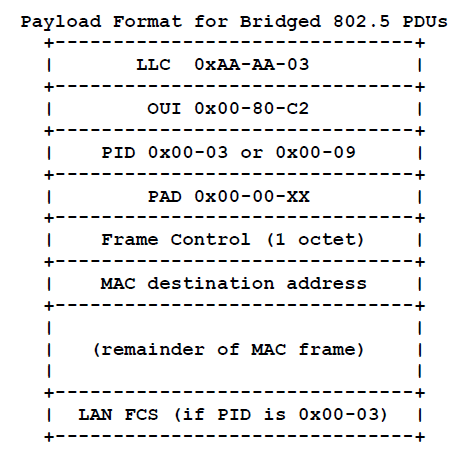
Since the 802.5 Access Control (AC) field has no significance outside the local 802.5 subnetworks, it is treated by this encapsulation as the last octet of the three octet PAD field. It MAY be set to any value by the sending bridge and MUST be ignored by the receiving bridge.
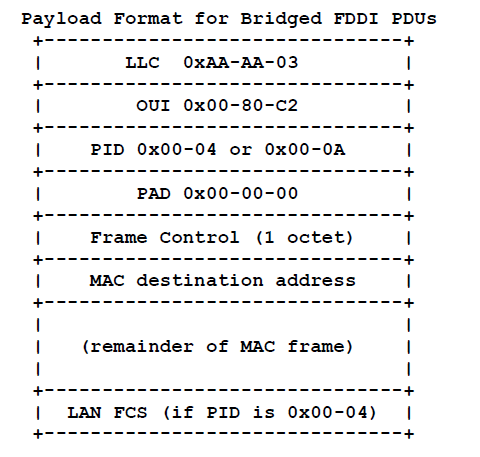
 In bridged 802.6 PDUs, the presence of a CRC-32 is indicated by the CIB bit in the header of the MAC frame. Therefore, the same PID value is used regardless of the presence or absence of the CRC-32 in the PDU.
In bridged 802.6 PDUs, the presence of a CRC-32 is indicated by the CIB bit in the header of the MAC frame. Therefore, the same PID value is used regardless of the presence or absence of the CRC-32 in the PDU.
 |  |  |
The Common Protocol Data Unit (PDU) Header and Trailer are conveyed to allow pipelining at the egress bridge to an 802.6 subnetwork. Specifically, the Common PDU Header contains the BAsize field, which contains the length of the PDU. If this field is not available to the egress 802.6 bridge, then that bridge cannot begin to transmit the segmented PDU until it has received the entire PDU, calculated the length, and inserted the length into the BAsize field. If the field is available, the egress 802.6 bridge can extract the length from the BAsize field of the Common PDU Header, insert it into the corresponding field of the first segment, and immediately transmit the segment onto the 802.6 subnetworks. Thus, the bridge can begin transmitting the 802.6 PDU before it has received the complete PDU.
Note that the Common PDU Header and Trailer of the encapsulated frame should not be simply copied to the outgoing 802.6 subnetworks because the encapsulated BEtag value may conflict with the previous BEtag value transmitted by that bridge.
An ingress 802.6 bridge can abort an AAL5 CPCS-PDU by setting its Length field to zero. If the egress bridge has already begun transmitting segments of the PDU to an 802.6 subnetwork and then notices that the AAL5 CPCS-PDU has been aborted, it may immediately generate an EOM cell that causes the 802.6 PDU to be rejected at the receiving bridge. Such an EOM cell could, for example, contain an invalid value in the Length field of the Common PDU Trailer.
 VC Multiplexing
VC Multiplexing
VC Multiplexing creates a binding between an ATM VC and the type of the network protocol carried on that VC. Thus, there is no need for protocol identification information to be carried in the payload of each AAL5 CPCS-PDU. This reduces payload overhead and can reduce per-packet processing. VC multiplexing can improve efficiency by reducing the number of cells needed to carry PDUs of certain lengths.
For ATM PVCs, the type of the protocol to be carried over each PVC MUST be determined by configuration. For ATM SVCs, the negotiations specified in RFC 1755 MUST be used.
VC Multiplexing of Routed Protocols
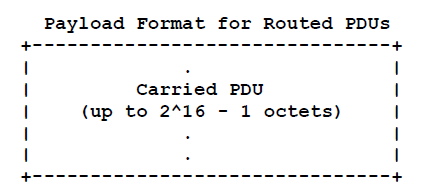
VC Multiplexing of Bridged Protocols
PDUs of bridged protocols MUST be carried in the Payload of the AAL5 CPCS-PDU exactly as described in section 5.2, except that only the fields after the PID field MUST be included. The AAL5 CPCS-PDU Payload field carrying a bridged PDU MUST, therefore, have one of the following formats.

 Note that the 802.5 Access Control (AC) field has no significance outside the local 802.5 subnetworks. It can thus be regarded as the last octet of the three octet PAD field, which in case of 802.5 can be set to any value (XX).
Note that the 802.5 Access Control (AC) field has no significance outside the local 802.5 subnetworks. It can thus be regarded as the last octet of the three octet PAD field, which in case of 802.5 can be set to any value (XX).
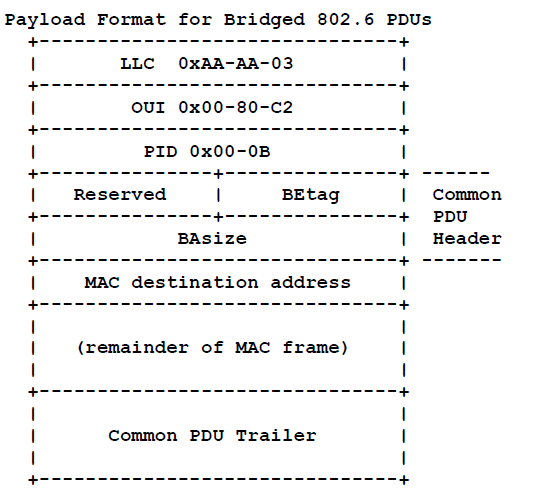
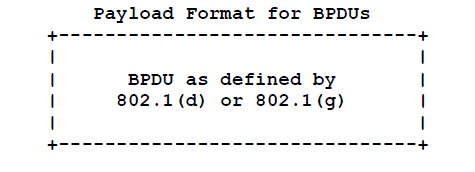 In case of Ethernet, 802.3, 802.4, 802.5, and FDDI PDUs the presence or absence of the trailing LAN FCS shall be identified implicitly by the VC since the PID field is not included. PDUs with the LAN FCS and PDUs without the LAN FCS are thus considered to belong to different protocols even if the bridged media type would be the same.
In case of Ethernet, 802.3, 802.4, 802.5, and FDDI PDUs the presence or absence of the trailing LAN FCS shall be identified implicitly by the VC since the PID field is not included. PDUs with the LAN FCS and PDUs without the LAN FCS are thus considered to belong to different protocols even if the bridged media type would be the same.
Bridging in an ATM Network
A bridge with an ATM interface that serves as a link to one or more other bridge MUST be able to flood, forward, and filter bridged PDUs.
Flooding is performed by sending the PDU to all possible appropriate destinations. In the ATM environment, this means sending the PDU through each relevant VC. This may be accomplished by explicitly copying it to each VC or by using a point-to-multipoint VC.
To forward a PDU, a bridge MUST be able to associate a destination MAC address with a VC. It is unreasonable and perhaps impossible to require bridges to statically configure an association of every possible destination MAC address with a VC. Therefore, ATM bridges must provide enough information to allow an ATM interface to dynamically learn about foreign destinations beyond the set of ATM stations.
Virtual Private Network (VPN) identification
VPN Encapsulation Header

LLC-encapsulated routed or bridged PDUs within a VPN
VC multiplexing of routed or bridged PDUs within a VPN
When a routed or bridged PDU is sent within a VPN using VC multiplexing, the VPN identifier MAY either be specified a priori, using ATM connection control signaling or administrative assignment to an ATM interface, or it MAY be indicated using an encapsulation header.
If the VPN is identified using ATM connection control signaling, all PDUs carried by the ATM VC is associated with the same VPN. In this case, the payload formats of routed and bridged PDUs MUST be as defined in sections 6.1 and 6.2, respectively. If a PDU is received containing a VPN encapsulation header when the VPN has been identified using ATM signaling, the receiver MAY drop it and/or take other actions which are implementation specific. Specification of the mechanism in ATM connection control signaling for carrying VPN identifiers is outside the scope of this Memo.
If a VPN identifier is administratively assigned to an ATM interface, then all PDUs carried by any ATM VCs within that interface are associated with that VPN. In this case, the payload formats of routed and bridged PDUs MUST be as defined in sections 6.1 and 6.2, respectively. If a PDU is received containing a VPN encapsulation header when the VPN identifier has been administratively assigned, the receiver MAY drop it and/or take other actions which are implementation specific. Specification of mechanisms (such as MIBs) for assigning VPN identifiers to ATM interfaces is outside the scope of this memo.
If the VPN identifier is to be indicated using an encapsulation header, then a VPN encapsulation header MUST be prepended to the appropriate routed or bridged PDU format.
Appendix A. Multiprotocol Encapsulation over FR-SSCS
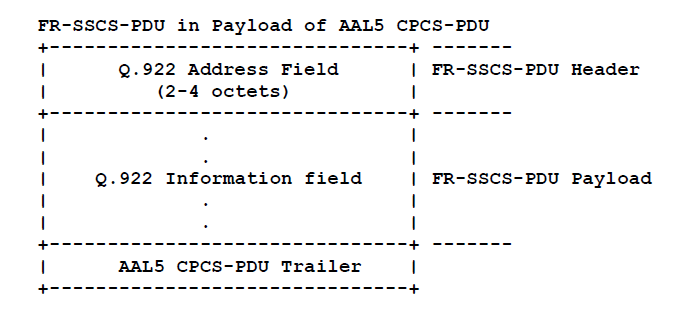 Routed and bridged PDUs are encapsulated inside the FR-SSCS-PDU as defined in RFC 2427. The Q.922 Information field starts with a Q.922 Control field followed by an optional Pad octet that is used to align the remainder of the frame to a convenient boundary for the sender. The protocol of the carried PDU is then identified by prefixing the PDU by an ISO/IEC TR 9577 Network Layer Protocol ID (NLPID).In the particular case of an IP PDU, the NLPID is 0xCC and the FR-SSCS-PDU has the following format:
Routed and bridged PDUs are encapsulated inside the FR-SSCS-PDU as defined in RFC 2427. The Q.922 Information field starts with a Q.922 Control field followed by an optional Pad octet that is used to align the remainder of the frame to a convenient boundary for the sender. The protocol of the carried PDU is then identified by prefixing the PDU by an ISO/IEC TR 9577 Network Layer Protocol ID (NLPID).In the particular case of an IP PDU, the NLPID is 0xCC and the FR-SSCS-PDU has the following format:
 Note that according to RFC 2427, the Q.922 Address field MUST be either 2 or 4 octets, i.e., a 3 octet Address field MUST NOT be used.In the particular case of a CLNP PDU, the NLPID is 0x81 and the FR-SSCS-PDU has the following format:
Note that according to RFC 2427, the Q.922 Address field MUST be either 2 or 4 octets, i.e., a 3 octet Address field MUST NOT be used.In the particular case of a CLNP PDU, the NLPID is 0x81 and the FR-SSCS-PDU has the following format:
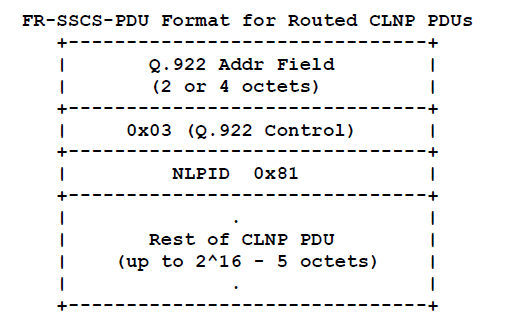 Note that in case of ISO protocols the NLPID field forms the first octet of the PDU itself and MUST not be repeated.
Note that in case of ISO protocols the NLPID field forms the first octet of the PDU itself and MUST not be repeated.
Appendix B. List of Locally Assigned values of OUI 00-80-C2
| with preserved FCS | w/o preserved FCS | Media |
| 0x00-01 | 0x00-07 | 802.3/Ethernet |
| 0x00-02 | 0x00-08 | 802.4 |
| 0x00-03 | 0x00-09 | 802.5 |
| 0x00-04 | 0x00-0A | FDDI |
| 0x00-05 | 0x00-0B | 802.6 |
| 0x00-0D | Fragments | |
| 0x00-0E | BPDUs |
Appendix C. Partial List of NLPIDs
Appendix D. Applications of multiprotocol encapsulation
Appendix E Differences from RFC 1483
- A pointer to RFC 2364 is added to cover the case of PPP over ATM
- RFC 1755 and RFC 2331 are referenced to describe how encapsulations are negotiated, rather than a long-obsolete CCITT (now ITU-T) working document and references to work then in progress.
- Usage of AAL5 is now a reference to ITU-T I.363.5. Options created in AAL5 since the publication of RFC 1483 are selected.
- Formatting of routed NLPID-formatted PDUs (which are called “routed ISO PDUs” in RFC 1483) is clarified
- Clarification is provided concerning the use of padding between the PID and MAC destination address in bridged PDUs and the bit ordering of the MAC address.
- Clarification is provided concerning the use of padding of Ethernet/802.3 frames
- A new encapsulation for VPNs is added
- Substantive security considerations were added
- A new appendix D provides a summary of applications of multiprotocol over ATM
Books you may interested
 |  |  |  |  |  |
 |  |  |
Sign up for URBkids.com Emails and receive 10% off discount




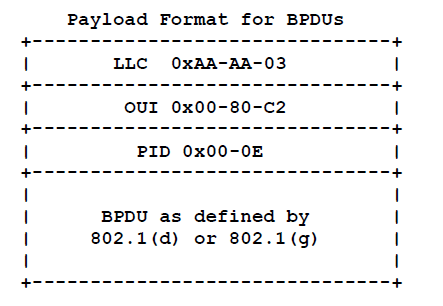 VC Multiplexing
VC Multiplexing
